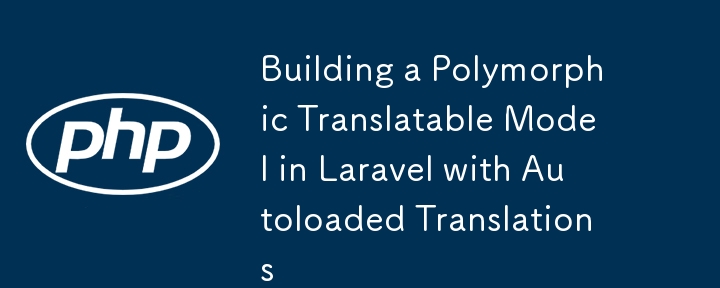使用自動載入翻譯在 Laravel 中建立多態可翻譯模型

處理多語言內容時,將翻譯儲存在 JSON 欄位中通常比每個屬性的單獨行儲存更有效。這種方法將翻譯整合到單一列中,從而簡化了資料管理和檢索。
設定翻譯系統
我們將增強翻譯模型和表,以使用 JSON 列來儲存翻譯。這將涉及更新表架構並修改 Translatable 特徵以處理 JSON 資料。
第 1 步:建立翻譯表遷移
如果翻譯表尚不存在,則建立新的遷移:
php artisan make:migration create_translations_table
第 2 步:定義表結構
在database/migrations中開啟產生的遷移檔案。對於新表,定義如下:
use Illuminate\Database\Migrations\Migration;
use Illuminate\Database\Schema\Blueprint;
use Illuminate\Support\Facades\Schema;
class CreateTranslationsTable extends Migration
{
public function up()
{
Schema::create('translations', function (Blueprint $table) {
$table->id();
$table->string('locale'); // Stores the locale, e.g., 'en', 'fr'
$table->string('translatable_type'); // Stores the related model type, e.g., 'Post', 'Product'
$table->unsignedBigInteger('translatable_id'); // Stores the ID of the related model
$table->json('translations'); // Stores all translations as a JSON object
$table->timestamps();
});
}
public function down()
{
Schema::dropIfExists('translations');
}
}
第 3 步:運行遷移
將遷移應用到您的資料庫:
php artisan migrate
第 4 步:建立翻譯模型
接下來,創建翻譯模型來處理多態關係:
php artisan make:model Translation
Translation模型中,定義多型關係:
class Translation extends Model
{
protected $fillable = ['locale', 'translatable_type', 'translatable_id', 'translations'];
protected $casts = [
'translations' => 'array',
];
public function translatable()
{
return $this->morphTo();
}
}
使用 JSON 儲存實現可翻譯特徵
為了讓翻譯處理可在多個模型中重複使用,我們將建立一個 Translatable 特徵,它將根據使用者選擇的區域設定自動載入翻譯內容。此外,如果所選語言環境沒有可用的翻譯,我們將新增後備機制以從預設語言環境載入內容。
第 1 步:使用 JSON 處理建立可翻譯特徵
namespace App\Traits;
use App\Models\Translation;
use Illuminate\Support\Facades\App;
trait Translatable
{
public static function bootTranslatable()
{
static::retrieved(function ($model) {
$model->loadTranslations();
});
}
public function translations()
{
return $this->morphMany(Translation::class, 'translatable');
}
public function loadTranslations()
{
$locale = App::getLocale();
$defaultLocale = config('app.default_locale', 'en'); // Fallback to the default locale
// Try to load translations for the current locale
$translation = $this->translations()->where('locale', $locale)->first();
if (!$translation && $locale !== $defaultLocale) {
// If no translations are found for the current locale, fallback to the default locale
$translation = $this->translations()->where('locale', $defaultLocale)->first();
}
if ($translation) {
$translations = $translation->translations;
foreach ($translations as $key => $value) {
$this->{$key} = $value;
}
}
}
public function addTranslations(array $translations, $locale = null)
{
$locale = $locale ?? App::getLocale();
return $this->translations()->updateOrCreate(
['locale' => $locale],
['translations' => $translations]
);
}
}
第 2 步:將可翻譯特徵應用於您的模型
將 Translatable 特徵加入任何需要翻譯支援的模型中。
namespace App\Models;
use App\Traits\Translatable;
use Illuminate\Database\Eloquent\Model;
class Post extends Model
{
use Translatable;
protected $fillable = ['title', 'content'];
}
範例:建立翻譯模型
將翻譯加入為 JSON 物件:
$post = Post::create(['title' => 'Default Title', 'content' => 'Default Content']);
// Adding translations
$post->addTranslations([
'title' => 'Hello World',
'content' => 'Welcome to our website'
], 'en');
$post->addTranslations([
'title' => 'Bonjour le monde',
'content' => 'Bienvenue sur notre site Web'
], 'fr');
檢索翻譯模型
當您檢索 Post 模型時,它將根據當前語言環境自動載入翻譯內容,或在必要時回退到預設語言環境:
App::setLocale('fr');
$post = Post::find(1);
echo $post->title; // Displays "Bonjour le monde" if French translation exists
App::setLocale('es');
$post = Post::find(1);
echo $post->title; // Displays "Hello World" as it falls back to the English translation
在檢視中顯示翻譯內容
在 Blade 視圖中,您可以像任何其他模型屬性一樣顯示翻譯的內容:
{{ $post->title }}
{{ $post->content }}
結論
透過使用 JSON 列來儲存翻譯並實現回退機制,您可以簡化 Laravel 應用程式中多語言內容的管理。這種方法將翻譯整合到單一列中,簡化了資料處理並使您的程式碼庫更易於維護。無論您是建立部落格、電子商務網站還是任何多語言應用程序,此方法都能確保流暢高效的用戶體驗。
享受!
-
 如何修復 Matplotlib 中的「無顯示名稱且無 $DISPLAY 環境變數」錯誤?"_tkinter.TclError: no display name and no $DISPLAY 環境變數"使用Matplotlib 執行Python 腳本時通常會發生此錯誤腳本時通常會發生此錯誤腳本時通常會發生此錯誤在沒有圖形顯示的伺服器上。 Matplotlib 依賴後...程式設計 發佈於2024-11-05
如何修復 Matplotlib 中的「無顯示名稱且無 $DISPLAY 環境變數」錯誤?"_tkinter.TclError: no display name and no $DISPLAY 環境變數"使用Matplotlib 執行Python 腳本時通常會發生此錯誤腳本時通常會發生此錯誤腳本時通常會發生此錯誤在沒有圖形顯示的伺服器上。 Matplotlib 依賴後...程式設計 發佈於2024-11-05 -
 您的第一個使用 Node.js 的後端應用程式您是否正在學習 Web 開發並對如何啟動 Node.js 專案感到困惑?別擔心,我有你!我將指導您只需 5 個步驟即可使用 Node.js 和 Express.js 建立您的第一個後端。 ️5個關鍵步驟: 第 1 步:設定項目 第 2 步:整理資料夾 第3步:建立server.js...程式設計 發佈於2024-11-05
您的第一個使用 Node.js 的後端應用程式您是否正在學習 Web 開發並對如何啟動 Node.js 專案感到困惑?別擔心,我有你!我將指導您只需 5 個步驟即可使用 Node.js 和 Express.js 建立您的第一個後端。 ️5個關鍵步驟: 第 1 步:設定項目 第 2 步:整理資料夾 第3步:建立server.js...程式設計 發佈於2024-11-05 -
 跨域場景下CORS何時使用預檢請求?CORS:了解跨域請求的「預檢」請求跨域資源共享(CORS) 在製作HTTP 時提出了挑戰跨域請求。為了解決這些限制,引入了預檢請求作為解決方法。 預檢請求說明預檢請求是先於實際請求(例如 GET 或 POST)的 OPTIONS 請求)並用於與伺服器協商請求的權限。這些請求包含兩個附加標頭:Acc...程式設計 發佈於2024-11-05
跨域場景下CORS何時使用預檢請求?CORS:了解跨域請求的「預檢」請求跨域資源共享(CORS) 在製作HTTP 時提出了挑戰跨域請求。為了解決這些限制,引入了預檢請求作為解決方法。 預檢請求說明預檢請求是先於實際請求(例如 GET 或 POST)的 OPTIONS 請求)並用於與伺服器協商請求的權限。這些請求包含兩個附加標頭:Acc...程式設計 發佈於2024-11-05 -
 如何使用 PHP 的 glob() 函數以副檔名過濾檔案?在 PHP 中以副檔名過濾檔案使用目錄時,通常需要根據副檔名擷取特定檔案。 PHP 提供了一種使用 glob() 函數來完成此任務的有效方法。 若要以副檔名過濾文件,請使用語法:$files = glob('/path/to/directory/*.extension');例如,要檢索目錄/path...程式設計 發佈於2024-11-05
如何使用 PHP 的 glob() 函數以副檔名過濾檔案?在 PHP 中以副檔名過濾檔案使用目錄時,通常需要根據副檔名擷取特定檔案。 PHP 提供了一種使用 glob() 函數來完成此任務的有效方法。 若要以副檔名過濾文件,請使用語法:$files = glob('/path/to/directory/*.extension');例如,要檢索目錄/path...程式設計 發佈於2024-11-05 -
 理解 JavaScript 中的 Promise 和 Promise Chaining什麼是承諾? JavaScript 中的 Promise 就像你對未來做某事的「承諾」。它是一個對象,表示非同步任務的最終完成(或失敗)及其結果值。簡而言之,Promise 充當尚不可用但將來可用的值的佔位符。 承諾國家 Promise 可以存在於以下三種狀態之一...程式設計 發佈於2024-11-05
理解 JavaScript 中的 Promise 和 Promise Chaining什麼是承諾? JavaScript 中的 Promise 就像你對未來做某事的「承諾」。它是一個對象,表示非同步任務的最終完成(或失敗)及其結果值。簡而言之,Promise 充當尚不可用但將來可用的值的佔位符。 承諾國家 Promise 可以存在於以下三種狀態之一...程式設計 發佈於2024-11-05 -
 Pip 的可編輯模式何時對本機 Python 套件開發有用?使用Pip 在Python 中利用可編輯模式進行本地包開發在Python 的包管理生態系統中,Pip 擁有“- e”(或'--editable') 特定場景的選項。什麼時候使用這個選項比較有利? 答案在於可編輯模式的實現,官方文件中有詳細說明:「從本地以可編輯模式安裝專案(即setu...程式設計 發佈於2024-11-05
Pip 的可編輯模式何時對本機 Python 套件開發有用?使用Pip 在Python 中利用可編輯模式進行本地包開發在Python 的包管理生態系統中,Pip 擁有“- e”(或'--editable') 特定場景的選項。什麼時候使用這個選項比較有利? 答案在於可編輯模式的實現,官方文件中有詳細說明:「從本地以可編輯模式安裝專案(即setu...程式設計 發佈於2024-11-05 -
 當您在瀏覽器中輸入 URL 時會發生什麼?您是否想知道當您在瀏覽器中輸入 URL 並按 Enter 鍵時幕後會發生什麼?這個過程比您想像的更加複雜,涉及多個步驟,這些步驟無縫地協同工作以提供您請求的網頁。在本文中,我們將探討從輸入 URL 到查看完全載入的網頁的整個過程,闡明使這一切成為可能的技術和協定。 第 1 步:輸入...程式設計 發佈於2024-11-05
當您在瀏覽器中輸入 URL 時會發生什麼?您是否想知道當您在瀏覽器中輸入 URL 並按 Enter 鍵時幕後會發生什麼?這個過程比您想像的更加複雜,涉及多個步驟,這些步驟無縫地協同工作以提供您請求的網頁。在本文中,我們將探討從輸入 URL 到查看完全載入的網頁的整個過程,闡明使這一切成為可能的技術和協定。 第 1 步:輸入...程式設計 發佈於2024-11-05 -
 如何有效管理大量小HashMap物件的「OutOfMemoryError:超出GC開銷限制」?OutOfMemoryError: Handling Garbage Collection OverheadOutOfMemoryError: Handling Garbage Collection Overhead在Java中,當過多時會出現「java.lang.OutOfMemoryError:...程式設計 發佈於2024-11-05
如何有效管理大量小HashMap物件的「OutOfMemoryError:超出GC開銷限制」?OutOfMemoryError: Handling Garbage Collection OverheadOutOfMemoryError: Handling Garbage Collection Overhead在Java中,當過多時會出現「java.lang.OutOfMemoryError:...程式設計 發佈於2024-11-05 -
![為什麼在 Python 列表初始化中使用 [[]] * n 時列表會連結在一起?](/style/images/moren/moren.png) 為什麼在 Python 列表初始化中使用 [[]] * n 時列表會連結在一起?使用[[]] * n 進行列表初始化時的列表連結問題使用[[]] 初始化列表列表時 n,程式設計師經常會遇到一個意想不到的問題,即列表似乎連結在一起。發生這種情況是因為 [x]n 語法建立對相同基礎清單物件的多個引用,而不是建立不同的清單實例。 為了說明該問題,請考慮以下代碼:x = [[]] * ...程式設計 發佈於2024-11-05
為什麼在 Python 列表初始化中使用 [[]] * n 時列表會連結在一起?使用[[]] * n 進行列表初始化時的列表連結問題使用[[]] 初始化列表列表時 n,程式設計師經常會遇到一個意想不到的問題,即列表似乎連結在一起。發生這種情況是因為 [x]n 語法建立對相同基礎清單物件的多個引用,而不是建立不同的清單實例。 為了說明該問題,請考慮以下代碼:x = [[]] * ...程式設計 發佈於2024-11-05 -
 Python 變得簡單:從初學者到進階 |部落格Python Course Code Examples This is a Documentation of the python code i used and created , for learning python. Its easy to understand and L...程式設計 發佈於2024-11-05
Python 變得簡單:從初學者到進階 |部落格Python Course Code Examples This is a Documentation of the python code i used and created , for learning python. Its easy to understand and L...程式設計 發佈於2024-11-05 -
 簡化 TypeScript 中的類型縮小和防護Introduction to Narrowing Concept Typescript documentation explains this topic really well. I am not going to copy and paste the same descrip...程式設計 發佈於2024-11-05
簡化 TypeScript 中的類型縮小和防護Introduction to Narrowing Concept Typescript documentation explains this topic really well. I am not going to copy and paste the same descrip...程式設計 發佈於2024-11-05 -
 何時應該使用 session_unset() 而不是 session_destroy() ,反之亦然?理解PHP 中session_unset() 和session_destroy() 的區別PHP 函數session_unset() 和session_destroy() 有不同的用途管理會話數據。儘管它們在清除會話變數方面有明顯相似之處,但它們具有不同的效果。 session_unset() 與s...程式設計 發佈於2024-11-05
何時應該使用 session_unset() 而不是 session_destroy() ,反之亦然?理解PHP 中session_unset() 和session_destroy() 的區別PHP 函數session_unset() 和session_destroy() 有不同的用途管理會話數據。儘管它們在清除會話變數方面有明顯相似之處,但它們具有不同的效果。 session_unset() 與s...程式設計 發佈於2024-11-05 -
 如何選擇在 C++ 中解析 INI 檔案的最佳方法?在C 中解析INI 檔案:各種方法指南在C 處理初始化(INI) 檔案時,開發人員經常遇到有效解析這些文件以提取所需資訊的挑戰。本文探討了用 C 解析 INI 檔案的不同方法,討論了它們的優點和注意事項。 本機 Windows API 函數一種方法是利用 Windows API 函數INI 檔案處理...程式設計 發佈於2024-11-05
如何選擇在 C++ 中解析 INI 檔案的最佳方法?在C 中解析INI 檔案:各種方法指南在C 處理初始化(INI) 檔案時,開發人員經常遇到有效解析這些文件以提取所需資訊的挑戰。本文探討了用 C 解析 INI 檔案的不同方法,討論了它們的優點和注意事項。 本機 Windows API 函數一種方法是利用 Windows API 函數INI 檔案處理...程式設計 發佈於2024-11-05
學習中文
- 1 走路用中文怎麼說? 走路中文發音,走路中文學習
- 2 坐飛機用中文怎麼說? 坐飞机中文發音,坐飞机中文學習
- 3 坐火車用中文怎麼說? 坐火车中文發音,坐火车中文學習
- 4 坐車用中文怎麼說? 坐车中文發音,坐车中文學習
- 5 開車用中文怎麼說? 开车中文發音,开车中文學習
- 6 游泳用中文怎麼說? 游泳中文發音,游泳中文學習
- 7 騎自行車用中文怎麼說? 骑自行车中文發音,骑自行车中文學習
- 8 你好用中文怎麼說? 你好中文發音,你好中文學習
- 9 謝謝用中文怎麼說? 谢谢中文發音,谢谢中文學習
- 10 How to say goodbye in Chinese? 再见Chinese pronunciation, 再见Chinese learning











![為什麼在 Python 列表初始化中使用 [[]] * n 時列表會連結在一起?](http://www.luping.net/uploads/20241021/17294774536715bb4d76111.jpg)













